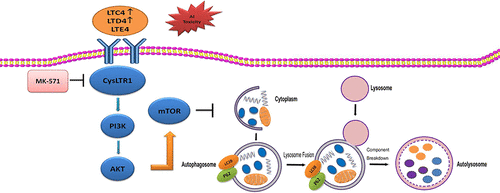CysLTR1 Blockage Ameliorates Liver Injury Caused by Aluminum-Overload via PI3K/AKT/mTOR-Mediated Autophagy Activation in Vivo and in Vitro
Congli Hu, Junqing Yang, Qin He, Ying Luo, Zhihao Chen, Lu Yang, Honggang Yi, Huan Li, Hui Xia, Dongzhi Ran, Yang Yang, Jiahua Zhang, Yuke Li, Hong Wang
Index: 10.1021/acs.molpharmaceut.8b00121
Full Text: HTML
Abstract

Aluminum (Al) is a trivalent cation that can accumulate in animal organs, especially in the liver. We previously demonstrated that Al-overload could induce liver morphologic aberrations and dysfunction. However, the molecular mechanism underlying liver injury caused by Al-overload still remains unknown. In the present study, we investigated the relationship between leukotrienes receptors and the PI3K/AKT/mTOR pathway in Al-induced liver injury in vivo and in vitro. We demonstrated that Al-overload significantly increased the protein expression levels of CysLTR1, PI3K, AKT, mTOR, and p62, while significantly decreasing the LC3BII protein levels in rat liver; thus, suggesting that the autophagy process was inhibited in Al-overloaded rat liver. In addition, MK-571, an inhibitor of CysLTR1, effectively protected the human hepatocyte L02 cells against injury caused by Al exposure. Moreover, CysLTR1 blockage could significantly down-regulate the PI3K/AKT/mTOR pathway and activate autophagy. The effect of MK-571 on cell viability was abolished by the treatment with the autophagy inhibitor (wortmannin) but not with the autophagy agonist (rapamycin). Taken together, our results indicated that the blockage of the leukotriene receptor of CysLTR1 promotes autophagy and further reduces hepatocyte death through the PI3K/AKT/mTOR pathway inhibition. CysLTR1 thus could represent a potential target for the new drug development for chronic noninfective liver injury.
|
Grapefruit Flavonoid Naringenin Regulates the Expression of ...
2018-04-19 [10.1021/acs.molpharmaceut.7b00797] |
|
A Triazole Disulfide Compound Increases the Affinity of Hemo...
2018-04-18 [10.1021/acs.molpharmaceut.8b00108] |
|
Application of a Salt Coformer in a Co-Amorphous Drug System...
2018-04-13 [10.1021/acs.molpharmaceut.8b00174] |
|
Treatment of Canine Oral Melanoma with Nanotechnology-Based ...
2018-04-12 [10.1021/acs.molpharmaceut.8b00126] |
|
In Vivo Introduction of mRNA Encapsulated in Lipid Nanoparti...
2018-04-11 [10.1021/acs.molpharmaceut.7b01084] |